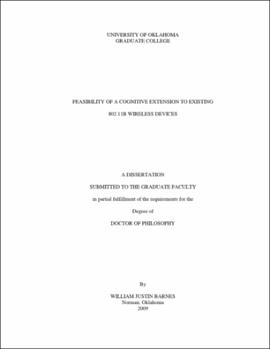| dc.contributor.advisor | Refai, Hazem H | |
| dc.creator | Barnes, William | |
| dc.date.accessioned | 2019-05-01T17:25:56Z | |
| dc.date.available | 2019-05-01T17:25:56Z | |
| dc.date.issued | 2009 | |
| dc.identifier | 99154002602042 | |
| dc.identifier.uri | https://hdl.handle.net/11244/319526 | |
| dc.description.abstract | Cognitive radio presents a means of altering the communication method of a wireless device based on channel conditions and the intended receiving device. However, the design of such a radio is very complicated as it must consider the possibility of multiple forms of modulation, differing transmit frequencies and symbol rates, and the accompany changes to other training procedures such as synchronization. This work proposes that in some cases a simpler, more cost-effective approach can be taken, that builds upon the architecture of existing wireless devices forming a new radio with cognitive capabilities. This approach allows the base device to perform all baseband and MAC-related functions with minimal or no negative effects due to the extension. As changes in modulation type are much more complex, the analysis in this work is restricted to systems wanting to intelligently alter their transmit frequency or power, such as the 802.22 standard. Because of the extensive investment that has already been made in 802.11 technology, 802.11b chipsets and APs are very inexpensive. Therefore a frequency conversion extension was designed and tested as the fixed architecture to enable signal conversion of an 802.11b signal. Cognitive functionalities could be added with little modification to the proposed design in this work. | |
| dc.description.abstract | The overall goal of this work is to achieve throughput and packet loss results comparable to the base design at the converted frequency of approximately 1.7 GHz. The successful conversion with a fixed design proves the concept feasible, as the only additional requirement is to interface a cognitive subsystem with a configurable architecture employing the same design as the fixed architecture. The nodes under test were isolated in an anechoic chamber to prevent interference from nearby networks. A program called IxChariot is used to experimentally conduct network performance tests to confirm that the extended device operates nearly identically to a normal 802.11b radio. Tests were performed for one-hop and two-hop scenarios collecting throughput and packet loss statistics. A number of undesirable effects such as increased switching delay time are also examined as well as their impact on the MAC and physical layer of the base device. The results of testing established the feasibility of a cognitive extension with no perceivable throughput/packet loss degradation for reasonable switching delays. Analysis of poor switching delay performance and 802.11g is also presented to illustrate the additional design constraints these challenges present. | |
| dc.format.extent | 158 pages | |
| dc.format.medium | application.pdf | |
| dc.language | en_US | |
| dc.relation.requires | Adobe Acrobat Reader | |
| dc.subject | Cognitive radio networks | |
| dc.subject | Wireless LANs | |
| dc.subject | IEEE 802.11 (Standard) | |
| dc.title | Feasibility of a Cognitive Extension to Existing 802.11b Wireless Devices | |
| dc.type | text | |
| dc.type | document | |
| dc.thesis.degree | Ph.D. | |
| ou.group | College of Engineering::School of Electrical and Computer Engineering | |
